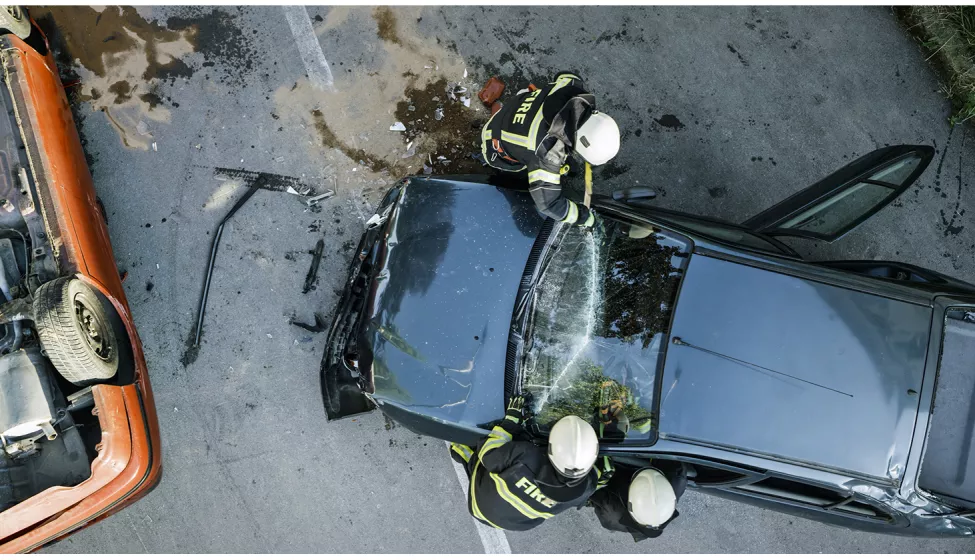April 29, 2021
The inordinate complexity of post-collision vehicle fires, as well as the severe consequences of injury and property loss from these events, has long been of concern to the engineering community and the public at large. Though the principles of fire science, vehicle mechanics, materials science, and accident reconstruction apply to post-collision fire analysis for all vehicles, drivers across the globe are increasingly trading conventional vehicles for those with more advanced technologies, some which carry new risks.
Hybrid and electric drivetrains are replacing the traditional internal combustion engine with on-board batteries, electric motors, and hydrogen fuel cells, and advanced driver assistance systems (ADAS) are increasingly performing aspects of the driving task. While these advancements are designed to benefit mobility, health, and safety, the addition of novel energy sources presents new challenges to designers, manufacturers, consumers, firefighters, and post-fire investigators.
Following a serious collision fire, it is important for origin and cause to be determined as accurately as possible.
Unfortunately, best practices in the general fire investigation community often do not yet account for the technological complexities associated with the heat sources and design features of hybrid, electric, and autonomous vehicles.
Properly determining the cause of post-collision fires in technologically advanced vehicles often requires the collaboration of mechanical, thermal, electrical, and battery engineers with expertise in fire and crash investigations as well as advanced vehicle systems.
Complexities of Post-Collision Fire Investigations
Structural, thermal, and electrical damages are often closely coupled in vehicle post-collision fires, which makes investigation complex. Because the cause of fire is usually related to crush or distortion of vehicle components, investigators must carefully consider collision dynamics when determining the root cause of a fire.
One advantage of advanced-technology vehicles is that their electronics-rich systems often record extensive data that provide quantifiable information about the collision event and clues as to fire cause. But the additional electronic components, batteries, and high-voltage systems also increase the complexity of crash and fire analyses and create unique challenges for both fire suppression and fire investigation.
Fires in lithium-ion batteries can reach very high local temperatures, leading to difficulty in extinguishment and unconventional damage patterns. Vehicles with such batteries may also self-ignite many hours after a fire is extinguished, requiring additional suppression efforts and causing thermal damage that an investigator must consider.
As such, post-collision fire investigations of advanced-technology vehicles may require an evaluation of a battery's performance, review of thermal or mechanical abuse on vehicle systems, and an understanding of burn patterns that may differ from those in conventional vehicle fires.
Assessing Root Cause
As advanced vehicle technologies become more mainstream, fire investigation strategies must adapt to account for the above complexities. This includes partnering with independent third parties who can leverage their knowledge of conventional collision fires by overlaying advanced vehicle, thermal, structural, and battery expertise to assessments of damage, fire origin, and root cause.
How Exponent Can Help
Our team at Exponent begins post-collision fire investigations at the macro level by determining the dynamics of the collision and origin of the fire before drilling down into the causal details. Our highly experienced staff follow the guidance of tried-and-true investigation techniques, such as the scientific process outlined in NFPA 921. If an investigation warrants extensive assessment, we have the expertise and facilities to perform in-depth studies.
At our Phoenix Test & Engineering Center, we perform a gamut of analyses, from full-scale crash tests with fully fueled or charged vehicles to assess collision dynamics and fire risk, to full-scale vehicle burn tests and custom flammability tests to assess potential modes of fire initiation and spread. The inferences obtained from this wide variety of scientific tests and engineering analyses are often necessary to understand the many complexities of post-collision vehicle fires and determine the root cause of incidents for all types of vehicles.


